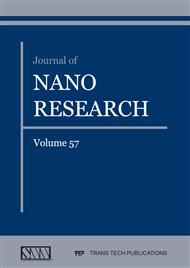[1]
Cheng, S.-S., et al., Synthesis, crystal structure, spectroscopic properties and potential anti-cancerous activities of four unsaturated bis-norcantharimides. Journal of Molecular Structure, 2016. 1115: pp.228-240.
DOI: 10.1016/j.molstruc.2016.02.093
Google Scholar
[2]
Rossetti, I. and M. Compagnoni, Chemical reaction engineering, process design and scale-up issues at the frontier of synthesis: Flow chemistry. Chemical Engineering Journal, 2016. 296: pp.56-70.
DOI: 10.1016/j.cej.2016.02.119
Google Scholar
[3]
Seth, S.K., et al., Exploring contribution of intermolecular interactions in supramolecular layered assembly of naphthyridine co-crystals: Insights from Hirshfeld surface analysis of their crystalline states. Journal of Molecular Structure, 2013. 1048: pp.157-165.
DOI: 10.1016/j.molstruc.2013.05.048
Google Scholar
[4]
Weiss Iv, W.F., T.M. Young, and C.J. Roberts, Principles, approaches, and challenges for predicting protein aggregation rates and shelf life. Journal of Pharmaceutical Sciences, 2009. 98(4): pp.1246-1277.
DOI: 10.1002/jps.21521
Google Scholar
[5]
Görbitz, C.H., Peptide structures. Current Opinion in Solid State and Materials Science, 2002. 6(2): pp.109-116.
DOI: 10.1016/s1359-0286(02)00044-x
Google Scholar
[6]
Piela, L., Chapter 13 - Intermolecular Interactions, in Ideas of Quantum Chemistry (Second Edition). 2014, Elsevier: Oxford. pp.793-882.
DOI: 10.1016/b978-0-444-59436-5.00013-1
Google Scholar
[7]
Banik, R., et al., Supramolecular interactions through lone pair(lp)–π and hydrogen bonding in cobalt(III) and manganese(II) derivatives of N,N'-dimethylvioluric acid: A combined experimental and theoretical study. Inorganica Chimica Acta, 2015. 435: pp.178-186.
DOI: 10.1016/j.ica.2015.06.018
Google Scholar
[8]
Brewer, G., et al., Synthesis, structure and supramolecular features of homonuclear iron(III) and heteronuclear iron(III)–cobalt(III) complexes, [FeH3L][ML](ClO4)3 (M = Fe(III) or Co(III). 2D sheet and tetrahedral arrays. Inorganica Chimica Acta, 2014. 421: pp.100-109.
DOI: 10.1016/j.ica.2014.05.034
Google Scholar
[9]
Brewer, G., et al., Synthesis, structure and supramolecular features of cobalt(III) and cobalt(II) complexes, [CoHxL](ClO4)y (x = y = 3, 2, 1.50, 1.45, 1 and 0 and x = 3, y = 2) of a triprotic imidazole containing Schiff base ligand. Effect of protonation state on supramolecular structure. Inorganica Chimica Acta, 2014. 410: pp.94-105.
DOI: 10.1016/j.ica.2013.10.017
Google Scholar
[10]
Liu, W., et al., Helix Packing Moments Reveal Diversity and Conservation in Membrane Protein Structure. Journal of Molecular Biology, 2004. 337(3): pp.713-729.
DOI: 10.1016/j.jmb.2004.02.001
Google Scholar
[11]
Zong, C., Packing, covering and tiling in two-dimensional spaces. Expositiones Mathematicae, 2014. 32(4): pp.297-364.
DOI: 10.1016/j.exmath.2013.12.002
Google Scholar
[12]
Zhao, N., et al., Syntheses, structures and third-order nonlinear optical properties of three coordination polymers based on bis(imidazol-l-yl-methyl)benzene and aromatic dicarboxylic ligands. Polyhedron, 2015. 85: pp.607-614.
DOI: 10.1016/j.poly.2014.09.021
Google Scholar
[13]
Mumbaraddi, D., S. Sarkar, and S.C. Peter, A review on the synthesis, crystal growth, structure and physical properties of rare earth based quaternary intermetallic compounds. Journal of Solid State Chemistry, 2016. 236: pp.94-115.
DOI: 10.1016/j.jssc.2015.10.032
Google Scholar
[14]
An, B., Y.-S. Lin, and B. Brodsky, Collagen interactions: Drug design and delivery. Advanced Drug Delivery Reviews, 2016. 97: pp.69-84.
DOI: 10.1016/j.addr.2015.11.013
Google Scholar
[15]
Dass, C., 9.12 - Mass Spectrometry: Structure Determination of Proteins and Peptides, in Comprehensive Natural Products II. 2010, Elsevier: Oxford. pp.457-496.
DOI: 10.1016/b978-008045382-8.00685-7
Google Scholar
[16]
Narh, C., et al., Sulfanilic acid inspired self-assembled fibrous materials. Colloid and Polymer Science, 2016. 294(9): pp.1483-1494.
DOI: 10.1007/s00396-016-3911-x
Google Scholar
[17]
Armstrong, A., J.E.K. Hildreth, and L.M. Amzel, Structural and Thermodynamic Insights into the Recognition of Native Proteins by Anti-Peptide Antibodies. Journal of Molecular Biology, 2013. 425(11): pp.2027-2038.
DOI: 10.1016/j.jmb.2013.02.031
Google Scholar
[18]
Hedwig, G.R. and H. Høiland, Thermodynamic properties of peptide solutions 20. Partial molar volumes and isothermal compressions for some tripeptides of sequence gly-X-gly (X = gly, ala, leu, asn, thr, and tyr) in aqueous solution at T = 298.15 K and p = (10–120) MPa. The Journal of Chemical Thermodynamics, 2016. 99: pp.30-39.
DOI: 10.1016/j.jct.2016.03.032
Google Scholar
[19]
Charaschanya, M., et al., Nucleophilic aromatic substitution of heterocycles using a high-temperature and high-pressure flow reactor. Tetrahedron Letters, 2016. 57(9): pp.1035-1039.
DOI: 10.1016/j.tetlet.2016.01.080
Google Scholar
[20]
Leushina, E., et al., SNAr nucleophilic substitution of 1,9-dihalodipyrrins by S- and N- nucleophiles. Synthesis of new dipyrrins bearing pendant substituents. Dyes and Pigments, 2016. 129: pp.149-155.
DOI: 10.1016/j.dyepig.2016.02.018
Google Scholar
[21]
Ren, Y., J. Yang, and S. Chen, The fate of a nitrobenzene-degrading bacterium in pharmaceutical wastewater treatment sludge. Chemosphere, 2015. 141: pp.13-18.
DOI: 10.1016/j.chemosphere.2015.05.098
Google Scholar
[22]
Pereira, R., et al., Fate of aniline and sulfanilic acid in UASB bioreactors under denitrifying conditions. Water Research, 2011. 45(1): pp.191-200.
DOI: 10.1016/j.watres.2010.08.027
Google Scholar
[23]
Gonzalez-Silva, B.M., et al., Nitrification at different salinities: Biofilm community composition and physiological plasticity. Water Research, 2016. 95: pp.48-58.
DOI: 10.1016/j.watres.2016.02.050
Google Scholar
[24]
Kim, Y.M., H. Park, and K. Chandran, Nitrification inhibition by hexavalent chromium Cr(VI) – Microbial ecology, gene expression and off-gas emissions. Water Research, 2016. 92: pp.254-261.
DOI: 10.1016/j.watres.2016.01.042
Google Scholar
[25]
Baran, J., A.J. Barnes, and H. Ratajczak, The polarized IR and Raman spectra of the diglycine hydrochloride crystal. Journal of Molecular Structure, 2012. 1009: pp.55-68.
DOI: 10.1016/j.molstruc.2011.09.016
Google Scholar
[26]
Baran, J.A., M.A. Drozd, and H. Ratajczak, Polarised IR and Raman spectra of monoglycine nitrate single crystal. Journal of Molecular Structure, 2010. 976(1–3): pp.226-242.
DOI: 10.1016/j.molstruc.2010.03.055
Google Scholar
[27]
Canè, E., et al., Infrared spectroscopy of 15ND3: The ν2 and ν4 bending fundamental bands. Journal of Quantitative Spectroscopy and Radiative Transfer, 2013. 119: pp.1-11.
DOI: 10.1016/j.jqsrt.2013.01.019
Google Scholar
[28]
Cao, C.-T., Y. Bi, and C. Cao, Effects of single bond-ion and single bond-diradical form on the stretching vibration of CN bridging bond in 4,4'-disubstituted benzylidene anilines. Spectrochimica Acta Part A: Molecular and Biomolecular Spectroscopy, 2016. 163: pp.96-101.
DOI: 10.1016/j.saa.2016.03.021
Google Scholar
[29]
Tursun, M. and C. Parlak, Conformation stability, halogen and solvent effects on CO stretching of 4-chloro-3-halogenobenzaldehydes. Spectrochimica Acta Part A: Molecular and Biomolecular Spectroscopy, 2015. 141: pp.58-63.
DOI: 10.1016/j.saa.2015.01.023
Google Scholar
[30]
Gorbitz, C.H., Nanotube formation by hydrophobic dipeptides. Chemistry-a European Journal, 2001. 7(23): pp.5153-5159.
Google Scholar
[31]
Yeap, G.-Y., et al., Molecular structure–thermal behaviour relationship of dimers consisting of different terminal substituents and sulphur–sulphur linking group. Journal of Molecular Structure, 2014. 1074: pp.666-672.
DOI: 10.1016/j.molstruc.2014.03.071
Google Scholar


